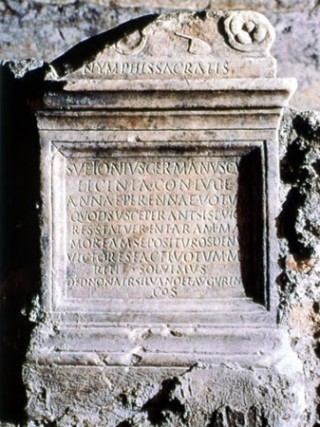Altar to the Holy Nymphs and Anna Perenna, dedicated by Suetonius Germanus and his wife Licinia on 5
Altar to the Holy Nymphs and Anna Perenna, dedicated by Suetonius Germanus and his wife Licinia on 5 April 156 CE. Sanctuary of Anna Perenna, Rome, Italy. Photo: L. Mandato.The Roman sanctuary of Anna Perenna was discovered in 1999. It dates from the Augustan era, and coins indicate it remained in use into the 4th century CE. Numerous votive offerings of coins, pine cones, amphorae, and lamps have been found in the sanctuary. Curse tablets, and anthropomorphic figurines made of wax and flour, preserved in leaden containers, and accompanied by inscriptions, are evidence that the site was extensively used for the practice of magic.Today, March 15, is the annual festival dedicated to Anna Perenna. This goddess has been identified with the sister of Dido, Queen of Carthage, with the Moon, with Themis, goddess of Divine Order, and with Amaltheia, the foster-mother of Zeus, but her origin may have been Etruscan.Romulus is said to have fixed the start of the Roman New Year at the Vernal Equinox. Since the date of this festival was originally on the New Moon in March, this could have been either the last New Moon of the Old Year, or the first New Moon of the New Year. Ovid says this was a popular festival, with public sacrifice and prayers in the goddess’ grove near the shores of the Tiber. Afterwards, people headed to the first milestone on the Via Flaminia, where they basked in the sun, sang, danced, drank wine, and prayed for as many more years of life as the number of cups they drank - which was, reportedly, quite a few.Linking all this information to the etymology of her name (from “annus”, meaning “year”, and “perennis‘, “lasting the year through”) suggests that Anna Perenna is most likely a goddess of the recurring year. Even though we no longer celebrate the New Year at the Vernal Equinox, it is still appropriate to honor her at this time, the beginning of Spring in the Northern Hemisphere, and the onset of Winter in the Southern Hemisphere. -- source link
Tumblr Blog : honorthegods.tumblr.com
#anna perenna#archaeology#religio romana#cultus deorum#roman polytheism
